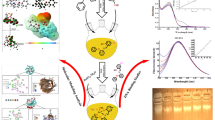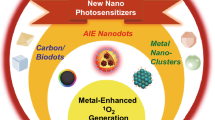Abstract
Photodynamic therapy (PDT) has drawn a great scientific attention to cancer treatment over the last decades. However, the bottleneck for the PDT is to find good photosensitizers (PSs) with greater water solubility, no aggregation, and fast discharge from the body. Therefore, there are still a big scientific desire for the synthesizing new rational PSs for treatment of cancer by PDT technique. In favor of improving the competence of PDT, an axially bis[4-(diphenylamino-1,1′-biphenyl-4-ol)] substituted silicon(IV) phthalocyanine (3) was converted to its water-soluble quaternized derivative (3Q). Their structures were fully characterized by single-crystal X-ray diffraction, elemental analysis, and different spectroscopic methods such as FT-IR, UV–Vis, MALDI-TOF, and 1H-NMR. The photophysical properties such as fluorescence quantum yields and lifetimes, and the photochemical properties such as singlet oxygen generation of both phthalocyanines were investigated. Ground and excited-state calculations were performed to explain the observed electronic absorption spectra. The addition of the 4-diphenylamino-1,1′-biphenyl-4-ol groups on the axially positions of the silicon(IV) phthalocyanine increased the singlet oxygen quantum yield from 0.15 to around 0.20. Especially quaternized compound 3Q showed high singlet oxygen quantum yield of 0.26 in water solution. In addition, a spectroscopic investigation of the binding behavior of the quaternized silicon (IV) phthalocyanine complex to bovine serum albumin (BSA) is also studied in this work, confirming the possible interaction. Further theoretical calculations were carried out to find out the plausible-binding regions of the BSA protein.
Graphic abstract

Axially bis[4-(diphenylamino-1,1′-biphenyl-4-ol)] substituted silicon(IV) phthalocyanine (3) was converted to its quaternized water soluble derivative (3Q). The photophysical properties such as fluorescence quantum yields and lifetimes, and the photochemical properties such as singlet oxygen generation of both phthalocyanines were investigated. In addition, a spectroscopic investigation of the binding behavior of the quaternized silicon (IV) phthalocyanine complex to bovine serum albumin (BSA) is also studied in this work, confirming the possible interaction. Further theoretical calculations were carried out to find out the plausible binding regions of the BSA protein.








Similar content being viewed by others
References
Leznoff CC, Lever ABP (1989, 1993, 1996) In Phthalocyanines: properties and applications, vol 1–4. VCH Publishers, New York
Durmuş M, Ahsen V (2010) Water-soluble cationic gallium(III) and indium(III) phthalocyanines for photodynamic therapy. J Inorg Biochem 104:297–309
Hu M, Brasseur N, Yıldız SZ, Van Lier JE, Leznoff CC (1998) Hydroxyphthalocyanines as potential photodynamic agents for cancer therapy. J Med Chem 41:1789–1802
Robertson CA, Evans DH, Abrahamse H (2009) Photodynamic therapy (PDT): a short review on cellular mechanisms and cancer research applications for PDT. J Photochem Photobiol B Biol 96:1–8
Dolmans DE, Fukumura D, Jain RK (2003) Photodynamic therapy for cancer. Nat Rev Cancer 3:380–387
Brown SB, Brown EA, Walker I (2004) The present and future role of photodynamic therapy in cancer treatment. Lancet Oncol 5:497–508
Detty MR, Gibson SL, Wagner SJ (2004) Current clinical and preclinical photosensitizers for use in photodynamic therapy. J Med Chem 47:3897–3915
Triesscheijn M, Baas P, Schellens JHM, Stewart FA (2006) Photodynamic therapy in oncology. Oncology 11:1034–1044
Bugaj AM (2011) Targeted photodynamic therapy–a promising strategy of tumor treatment. Photochem Photobiol Sci 10:1097–1109
Li X, Zheng B-D, Peng X-H, Li S-Z, Ying J-W, Zhao Y, Huang J-D, Yoon J (2019) Phthalocyanines as medicinal photosensitizers: developments in the last five years. Coord Chem Rev 379:147–160
Walter MG, Rudine AB, Wamser CC (2010) Porphyrins and phthalocyanines in solar photovoltaic cells. J Porphyr Phthalocyanines 14:759–792
Shen X-M, Jiang X-J, Huang C-C, Zhang H-H, Huang J-D (2010) Highly photostable silicon(IV) phthalocyanines containing adamantane moieties: synthesis, structure, and properties. Tetrahedron 66:9041–9048
Shen XM, Zheng BY, Huang XR, Wang L, Huang JD (2013) The first silicon(IV) phthalocyanine-nucleoside conjugates with high photodynamic activity. Dalton Trans 42:10398–10403
Zheng B-Y, Jiang X-J, Lin T, Ke M-R, Huang J-D (2015) Novel silicon(IV) phthalocyanines containing piperidinyl moieties: synthesis and in vitro antifungal photodynamic activities. Dyes Pigments 112:11–316
Zheng Y-W, Chen S-F, Zheng B-Y, Ke M-R, Huang J-D (2014) A silicon(IV) phthalocyanine-folate conjugate as an efficient photosensitizer. Chem Lett 43:1701–1703
Zheng B-Y, Yang X-Q, Zhao Y, Zheng Q-F, Ke M-R, Lin T, Chen R-X, Ho KKK, Kumar N, Huang J-D (2018) Synthesis and photodynamic activities of integrin-targeting silicon(IV) phthalocyanine-cRGD conjugates. Eur J Med Chem 155:24–33
Li X, Peng X-H, Zheng B-D, Tang J, Zhao Y, Zheng B-Y, Ke M-R, Huang J-D (2018) New application of phthalocyanine molecules: from photodynamic therapy to photothermal therapy by means of structural regulation rather than formation of aggregates. Chem Sci 9:2098–2104
So CW, Tsang PW, Lo PC, Seneviratne CJ, Samaranayake LP, Fong WP (2009) Photodynamic inactivation of Candida albicans by BAM-SiPc. Mycoses 53:215–220
Gergova R, Georgieva T, Angelov I, Mantareva V, Valkanov S, Mitov I, Dimitrov S (2012) Photodynamic therapy with water-soluble phthalocyanines against bacterial biofilms in teeth root canals Proc SPIE-Int Soc. Opt Eng 86:842744–842755
Zheng BY, Lin T, Yang HH, Huang JD (2013) Photodynamic inactivation of Candida albicans sensitized by a series of novel axially di-substituted silicon(IV) phthalocyanines. Dyes Pigments 96:547–553
Mantareva V, Angelov I, Kussovski V, Dimitrov R, Lapok L, Wöhrle D (2011) Photodynamic efficacy of water-soluble Si(IV) and Ge(IV) phthalocyanines toward Candida albicans planktonic and biofilm cultures. Eur J Med Chem 46:4430–4440
Lowery MK, Starshak AJ, Esposito JN, Krueger PC, Kenney ME (1965) Dichloro(phthalocyanino)silicon. Inorg Chem 4:128
Atmaca GY, Dizman C, Eren T, Erdogmus A (2015) Novel axially carborane-cage substituted silicon phthalocyanine photosensitizer; synthesis, characterization and photophysicochemical properties. Spectrochim Acta Mol Biomol Spectrosc 137:244–249
Enkelkamp H, Nolte RJM (2000) Molecular materials based on crown ether functionalized phthalocyanines. J Porphyr Phthalocyanines 4:454–459
Dominguez DD, Snow AW, Shirk JS, Pong RS (2001) Polyethyleneoxide-capped phthalocyanines: limiting phthalocyanine aggregation to dimer formation. J Porphyr Phthalocyanines 5:582–592
Gülmez AD, Göksel M, Durmuş M (2017) Silicon(IV) phthalocyanine-biotin conjugates: synthesis, photophysicochemical properties and in vitro biological activity for photodynamic therapy. J Porphyr Phthalocyanines 21:547–554
Ogunsipe A, Chen J-Y, Nyokong T (2004) Photophysical and photochemical studies of zinc(II) phthalocyanine derivatives—effects of substituents and solvents. New J Chem 28:822–827
Ömeroğlu İ, Kaya EN, Göksel M, Kussovski V, Mantareva V, Durmuş M (2017) Axially substituted silicon(IV) phthalocyanine and its quaternized derivative as photosensitizers toward tumor cells and bacterial pathogens. Bioorg Med Chem 25:5415–5422
Göksel M, Biyiklioglu Z, Durmuş M (2017) The water soluble axially di-substituted silicon phthalocyanines: photophysicochemical properties and in vitro studies. J Biol Inorg Chem 22:953–967
Al-Raqa SY, Khezami K, Kaya EN, Durmuş M (2021) A novel water soluble axially substituted silicon (IV) phthalocyanine bearing quaternized 4-(4-pyridinyl)phenol groups: synthesis, characterization, photophysicochemical properties and BSA/DNA binding behavior. Polyhedron 194:114937
Atmaca GY (2021) Measurement of singlet oxygen generation of 9-(hydroxymethyl)anthracene substituted silicon phthalocyanine by sono-photochemical and photochemical studies. J Mol Struct 1226:129320
Atmaca GY (2021) Investigation of singlet oxygen efficiency of di-axially substituted silicon phthalocyanine with sono-photochemical and photochemical studies. Polyhedron 193:114894
Durmuş M, Nyokong T (2008) Photophysicochemical and fluorescence quenching studies of benzyloxyphenoxy-substituted zinc phthalocyanines. Spectrochim Acta Part A 69:1170–1177
Durmuş M, Ahsen V, Nyokong T (2012) Photochemical and photophysical characterization: photosensitizers in medicine, environment, and security. Springer, Dordrecht Heidelberg, London, New York ((ISBN 978-90-481-3872-2))
Gürol I, Durmuş M, Ahsen V, Nyokong T (2007) Synthesis, photophysical and photochemical properties of substituted zinc phthalocyanines. Dalton Trans 34:82–91
Peng Y, Huang F, Wen J, Huang B, Ma X, Wang Q (2008) A spectroscopic study of the interaction of octacarboxylic metal phthalocyanine with bovine serum albumin. J Coord Chem 61:1503–1512
Krishnamoorthy P, Sathyadevi P, Cowley AH, Butorac RR, Dharmaraj N (2011) Evaluation of DNA binding, DNA cleavage, protein binding and in vitro cytotoxic activities of bivalent transition metal hydrazone complexes. Eur J Med Chem 46:3376–3387
Vignesh G, Arunachalam S, Vignesh S, James RA (2012) BSA binding and antimicrobial studies of branched polyethyleneimine–copper(II)bipyridine/phenanthroline complexes. Spectrochim Acta A 96:108–116
Murov SL, Carmichael I, Hug GL (1993) Handbook of photochemistry. M Decker, New York
Lakowicz JR (2006) Principles of fluorescence spectroscopy, 3rd edn. Springer, Berlin
Nunes SMT, Sguilla FS, Tedesco AC (2004) Photophysical studies of zinc phthalocyanine and chloroaluminum phthalocyanine incorporated into liposomes in the presence of additives. Braz J Med Biol Res 37:273–284
Çolak S, Durmuş M, Yıldız SZ (2016) Tetrakis{2-[N-((3-morpholino)propyl)carbamate]oxyethyl} zinc(II) phthalocyanine and its water soluble derivatives: synthesis, photophysical, photochemical and protein binding properties. J Photochem Photobiol A 325:125–134
Ömeroğlu İ, Göksel M, Kussovski V, Mantareva V, Durmuş M (2019) Novel water-soluble silicon(IV) phthalocyanine with powerful photodynamic efficacy against tumors and pathogenic bacteria. Macroheterocycles 12:255–263
Huang J-D, Lo P-C, Chen Y-M, Lai JC, Fong W-P, Ng DKP (2006) Preparation and in vitro photodynamic activity of novel silicon(IV) phthalocyanines conjugated to serum albumins. J Inorg Biochem 100:946–951
Bujacz A, Zielinski K, Sekula B (2014) Structural studies of bovine, equine, and leporine serum albumin complexes with naproxen. Proteins 82:2199–2208
Castagna R, Donini S, Colnago P, Serafini A, Parisini E, Bertarelli C (2019) Biohybrid electrospun membrane for the filtration of ketoprofen drug from water. ACS Omega 4:13270–13278
Kenny PW (2019) The nature of ligand efficiency. J Cheminformatics 11:2–18
Altschul SF, Wootton JC, Gertz EM, Agarwala R, Morgulis A, Schäffer AA, Yu Y-K (2005) Protein database searches using compositionally adjusted substitution matrices. FEBS J 272:5101–5109
Majorek KA, Porebski PJ, Dayal A, Zimmerman MD, Jablonska K, Stewart AJ, Chruszcz M, Minor W (2012) Structural and immunologic characterization of bovine, horse, and rabbit serum albumins. Mol Immunol 52:174–182
Li X, Jeong K, Lee Y, Guo T, Lee D, Park J, Kwon N, Na J-H, Hong SK, Cha S-S, Huang J-D, Choi S, Kim S, Yoon J (2019) Water-soluble phthalocyanines selectively bind to albumin dimers: a green approach toward enhancing tumor-targeted photodynamic therapy. Theranostics 9(22):6412–6423
Çakir V, Göksel M, Durmuş M, Biyiklioglu Z (2016) Synthesis and photophysicochemical properties of novel water soluble phthalocyanines. Dyes Pigments 125:414–425
Maree S, Nyokong T (2001) Syntheses and photochemical properties of octasubstituted phthalocyaninato zinc complexes. J Porphyr Phthalocyanines 5:782–792
Sahin B, Topal SZ, Atilla D (2017) Synthesis, photophysical and photochemical properties of a set of silicon phthalocyanines bearing anti-inflammatory groups. J Fluoresc 27:407–416
Acknowledgements
Khaoula Khezami would like to thank TUBITAK for the fellowship 2216, RESEARCH FELLOWSHIP PROGRAMME FOR INTERNATIONAL RESEARCHERS.
Author information
Authors and Affiliations
Corresponding author
Ethics declarations
Conflict of interest
There are no conflicts to declare.
Additional information
Publisher's Note
Springer Nature remains neutral with regard to jurisdictional claims in published maps and institutional affiliations.
Supplementary Information
Below is the link to the electronic supplementary material.
Rights and permissions
About this article
Cite this article
Al-Raqa, S.Y., Khezami, K., Kaya, E.N. et al. Experimental and theoretical investigation of water-soluble silicon(IV) phthalocyanine and its interaction with bovine serum albumin. J Biol Inorg Chem 26, 235–247 (2021). https://doi.org/10.1007/s00775-021-01848-w
Received:
Accepted:
Published:
Issue Date:
DOI: https://doi.org/10.1007/s00775-021-01848-w




